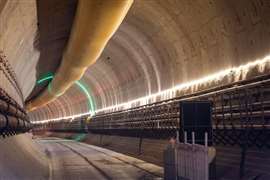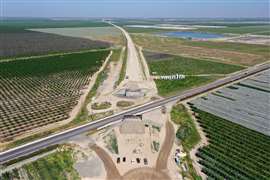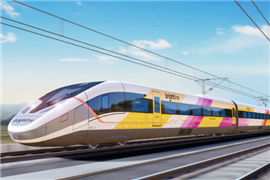Costs are making high-speed rail more challenging to build – is there a solution?
27 March 2024
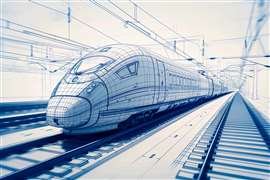 Image: Eduardo Lopez (generated with AI) via AdobeStock - stock.adobe.com)
Image: Eduardo Lopez (generated with AI) via AdobeStock - stock.adobe.com)
Decision-markers in charge of high-speed rail projects all over the world are warning that higher costs are making them more challenging to build.
That’s the finding from a new report by engineering consultancy Aecom, for which it has surveyed 105 people in charge of building, operating and regulating them.
Nearly three-quarters (73%) of respondents in Aecom’s report, From vision to reality: A new high-speed rail playbook, thought that rising costs of construction, equipment and materials could stop high-speed rail expansion in their region.
Meanwhile, 83% of respondents said they thought rising costs in those areas could stop high-speed rail projects in their region that are already underway.
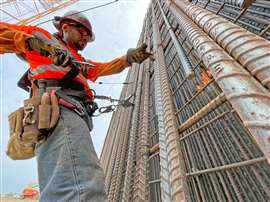 A worker on the Conejo Viaduct (Image: California High-Speed Rail Authority)
A worker on the Conejo Viaduct (Image: California High-Speed Rail Authority)
The global high-speed rail network has grown significantly in recent years. Lines that allow trains to run at more than 155mph (250kmh) have increased in length from around 27,000 miles (44,000 kilometres) in 2020, to around 37,000 miles (59,000 kilometres) by the end of 2022, according to the report.
But there have also been some high-profile examples recently of high-speed rail megaprojects struggling with a combination of rising costs and/or wavering political support.
Most notably, there was the scaling down of the HS2 project in the UK. The UK government announced in October 2023 that it was scrapping the second phases of the project, limiting it to just the first phase, which runs between London and Birmingham (see below). The project was already well over budget and behind schedule, with inflation adding to the final bill.
Interestingly, 71% of those surveyed in the Aecom report thought that projects should be allowed to go significantly (ie 30%) over budget, as well as accepting three years or more of delay if the high-speed rail project minimise a negative impact on the environment or society.
The report identified several areas that are crucial to ensuring that high-speed rail megaprojects stay on track, including keeping on top of regulatory and environmental issues, acquiring land and rights of way before starting construction, ensuring stable and long-term funding, and maintaining strong political support.
Next generation of high-speed rail could help bring down costs
But it also identified ways in which projects of the future can be designed and built to keep a lid on costs that might otherwise spiral.
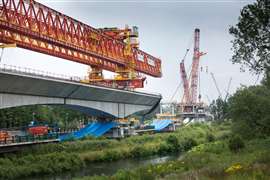 Progress being made on the Colne Valley Viaduct - the UK’s longest rail bridge - in August 2023. (Image: HS2)
Progress being made on the Colne Valley Viaduct - the UK’s longest rail bridge - in August 2023. (Image: HS2)
In fact, 79% of respondents to the survey said they were excited about the prospects for new construction methods, which may reduce the time and cost required to get projects operational.
It pointed to mainland China, which has pioneered the use of prefabrication of large structures for assets like bridges, built to standardised designs and then craned into place, helping to being down the cost of projects.
Aecom suggested that more advanced construction methods, innovative technologies and standardised or modular approaches could speed up development and construction.
Interviewed for the report, China Railway Construction Company International (CRCCI) deputy general manager, technology department, Zhang Hongping said, “We embrace the concept of intelligent railway technology, which spans big data, artificial intelligence, digitalization and building information modelling (BIM).
“It will change a great deal — enabling us to reduce costs, improve sustainability, and operate a faster and more comfortable service.”
And Aecom pointed to other examples of standardisation and modular construction on high-speed rail infrastructure, such as within Saudi Arabia’s special economic zone Neom, where tunnels are being constructed using the cut-and-cover method and pre-fabricated arches are being used to save time, cost and carbon.
In addition to new design and construction methods and technologies to bring down costs, as well as a push for national and international standardisation and modular construction where possible, the report recommended:
- Long-term, decision political leadership to speed up planning, regulatory and land acquisition processes.
- New funding models to secure affordable financing more quickly, potentially learning from other infrastructure projects. The report highlighted emerging examples of projects, like Brightline in the US between Miami and Orlando, which has secured private equity backing.
- Design to cost (DTC) and disciplined cost control. DTC involves identifying and evaluating cost drivers early and using this to inform design decisions. Control measures can then build on this.
- Bringing contractors in early to work together under alternative delivery methods and working with education providers to develop specific skills.
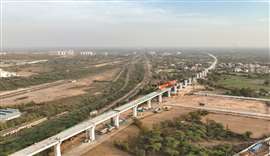 Construction of a viaduct for the high-speed rail line in Ahmedabad district, Gujarat, India (Image: National High Speed Rail Coroporation)
Construction of a viaduct for the high-speed rail line in Ahmedabad district, Gujarat, India (Image: National High Speed Rail Coroporation)
The report concluded, “The cost of high-speed rail is especially challenging in times of fiscal and economic uncertainty, slow growth or recession. It is worth noting, however, that successful high-speed rail networks – such as those in Japan, China and Europe – were born from long-term, stable commitment and funding maintained through cyclical phases, market shocks and recessions.
“Design standardisation, modularisation, pre-fabrication and economies of scale are all powerful levers that developers can use to lower costs. These are among the main reasons why China’s high-speed rail lines are built at just two-thirds the cost of those in other countries. In Europe, the development of high-speed rail has typically been made more affordable through interoperability with existing rail networks. This allows for a flexible, incremental approach that lowers both political and financial risk.
“High speed rail represents a golden opportunity to get the world moving in a cleaner, faster and safer way and brings cities closer together...Get it right and high-speed rail delivers a winning mix of benefits that will put it at the heart of our sustainable transportation systems of the future.”
To read Aecom’s report on high-speed rail in full, click here.
To read more of Construction Briefing’s coverage on high-speed rail projects around the world, see below.
STAY CONNECTED



Receive the information you need when you need it through our world-leading magazines, newsletters and daily briefings.
CONNECT WITH THE TEAM









